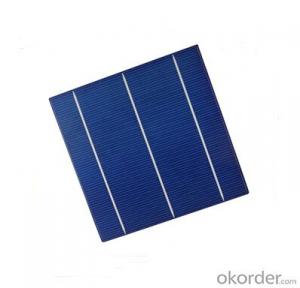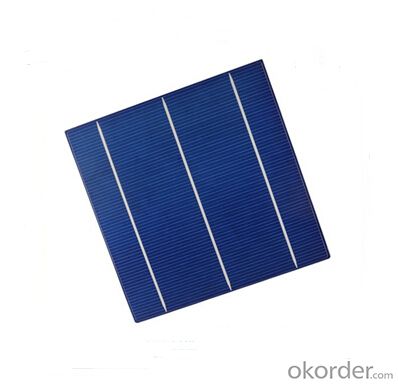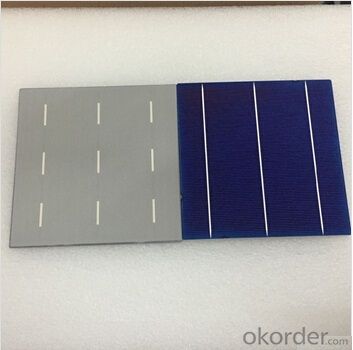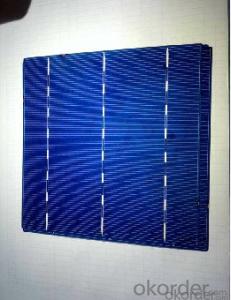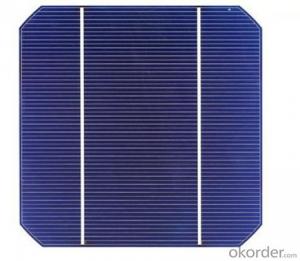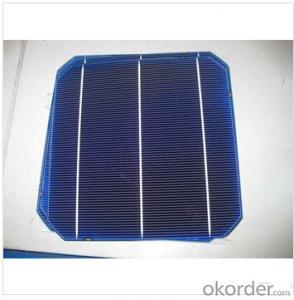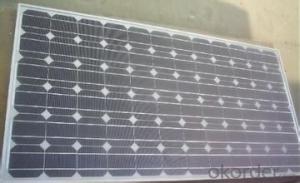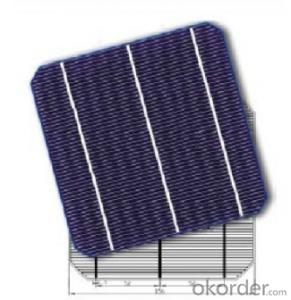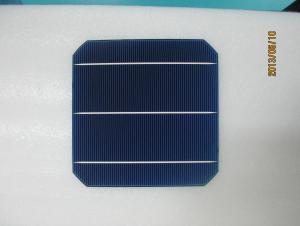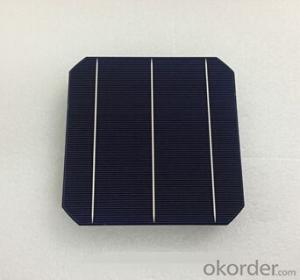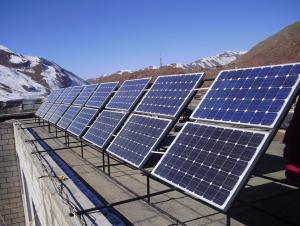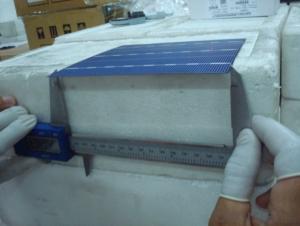Spectrolab Xtj Monocrystalline Solar Cell 156mm*156mm±0.5mm
- Loading Port:
- Shanghai
- Payment Terms:
- TT OR LC
- Min Order Qty:
- 3000 pc
- Supply Capability:
- 300000 pc/month
OKorder Service Pledge
OKorder Financial Service
You Might Also Like
Solar Cells:
solar cells, when struck by photons of light from the sun, generates an electrical current which can then be used to power DC or AC electrical loads.
A solar cell is made of silicon. Computer chips are made of this same material. Basically, when light strikes the surface of a solar cell some of it is absorbed into the silicon. This light energy bumps the electrons loose and causes energy to flow
Solar cells is made by solar wafer, it has three categories of solar cell right now, monocrystalline polycrystalline and thin film,These cells are entirely based around the concept of PN junction, which is the critical part of solar module, it is the part that can convert the light energy into electricity, the thickness is from 180um to 200um, with even busbars to conduct electricity, textured cell can decrease diffuse reflection; they are often electrically connected and encapsulated as a module. Photovoltaic modules often have a sheet of glass on the front (sun up) side, allowing light to pass while protecting semiconductor wafers from abrasion and impact due to wind-driven debris, rain, hail, etc. Solar cells are also usually connected in series in modules, creating an additive voltage. Connecting cells in parallel will yield a higher current;With high quality and stable quality. Our Cells can greatly improve the performance of Solar Modules.
Features:
High efficiencies up to 16.4%
Proven long term mechanical stability of silicone
Make of highly purified poly silicone
Three bus bars for reduced series resistance and improved module and cell efficiency
Blue anti-reflecting coating ensures improved light absorption and increased efficiency
Acid texturization offers a uniform appearance and virtually invisible crystal structure
Excellent low light behavior for improved energy yield
Specifications
Cells | Monocrystalline Solar Cell | Intensity[W/m2] | Isc *[mA] | Voc*[mV] | ||||||
Format | 156mm*156mm±0.5mm | 1000 | 1 | 1 | ||||||
Thickness | 190um±20um | 900 | 0.9 | 0.994 | ||||||
Front(-) | 1.4mm bus bars (silver), | 500 | 0.5 | 0.969 | ||||||
blueanti-reflectingcoating (silicon nitride) | 300 | 0.3 | 0.946 | |||||||
Back(+) | 3mm wide soldering pads (silver) | 200 | 0.2 | 0.926 | ||||||
Back surface field (aluminium) | ||||||||||
Electrical typical values | ||||||||||
Product model | Eff. % | Pmax (W) | Vpm(V) | Ipm (A) | Voc(V) | Isc(A) | ||||
18.20%-4.429W | EFF≥18.20% | Pmax ≥4.429 | 0.535±3 | 8.2785 | 0.636 | 8.815 | ||||
18.00%-4.380W | 18.20%>EFF≥18.00% | 4.429>Pmax ≥4.380 | 0.534±3 | 8.2022 | 0.635 | 8.753 | ||||
17.80%-4.332W | 18.00%>EFF≥17.80% | 4.380>Pmax ≥4.332 | 0.533±3 | 8.1088 | 0.634 | 8.704 | ||||
17.60%-4.283W | 17.80%>EFF≥17.60% | 4.332>Pmax ≥4.283 | 0.531±3 | 8.0662 | 0.633 | 8.620 | ||||
17.40%-4.234W | 17.60%>EFF≥17.40% | 4.283>Pmax ≥4.234 | 0.530±3 | 7.9896 | 0.632 | 8.610 | ||||
17.20%-4.186W | 17.40%>EFF≥17.20% | 4.234>Pmax ≥4.186 | 0.529±3 | 7.9127 | 0.631 | 8.529 | ||||
17.00%-4.137W | 17.20%>EFF≥17.00% | 4.186>Pmax ≥4.137 | 0.527±3 | 7.8503 | 0.630 | 8.459 | ||||
16.80%-4.088W | 17.00%>EFF≥16.80% | 4.137>Pmax ≥4.088 | 0.524±3 | 7.8024 | 0.629 | 8.397 | ||||
16.60%-4.040W | 16.80%>EFF≥16.60% | 4.088>Pmax ≥4.040 | 0.521±3 | 7.7539 | 0.627 | 8.239 | ||||
16.40%-3.991W | 16.60%>EFF≥16.40% | 4.040>Pmax ≥3.991 | 0.519±3 | 7.6900 | 0.625 | 8.198 | ||||
16.20%-3.942W | 16.40%>EFF≥16.20% | 3.991>Pmax ≥3.942 | 0.516±3 | 7.6404 | 0.623 | 8.153 | ||||
16.00%-3.894W | 16.20%>EFF≥16.00% | 3.942>Pmax ≥3.894 | 0.514±3 | 7.5754 | 0.620 | 8.145 | ||||
Solar Cells Advantage:
1. High efficiency and High power.
2. Long-term electrical stability.
3. Lowest price and Fastest delivery.
4. Good quality and good service.
5.Bulk supply
6. Good Warranty
7.Big Sale
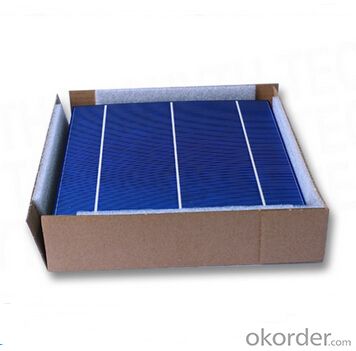
FAQ
We have organized several common questions for our clients,may help you sincerely:
1, What’s price per product ?
A: It’s depends on the quantity, delivery date and payment terms of the order. We can talk further about the detail price issue. Our products is high quality with lower price level.
2, How to make payment?
We accept T/T or L/C.
3, What is your lead time?
Generally 1-5 weeks depends on the order quantity and your specific requirements.
4, Can you do OEM for us?
Yes, we can.
5, How do you pack your products?
We have rich experience on how to pack the panels to make sure the safety on shipment when it arrives at the destination.
- Q: What is the average lifespan of a solar cell?
- The average lifespan of a solar cell is typically around 25 to 30 years.
- Q: What is the role of junction boxes in solar cell systems?
- Junction boxes in solar cell systems serve as important components that provide electrical connections and protect the solar panels. They house the electrical connections between multiple solar panels, ensuring a safe and efficient flow of electricity. Additionally, junction boxes act as a barrier, protecting the wiring and connections from environmental factors such as moisture and dust. Overall, junction boxes play a crucial role in the functionality and longevity of solar cell systems.
- Q: Are solar cells durable?
- Yes, solar cells are generally durable. They are designed to withstand various environmental conditions such as heat, humidity, and extreme temperatures. Additionally, most solar cells are made with materials that have a long lifespan and are resistant to degradation. However, proper maintenance and protection are necessary to ensure their longevity.
- Q: How do solar cells perform in areas with high winds?
- Solar cells can generally perform well in areas with high winds, as they are designed to withstand various weather conditions. However, excessive wind speeds can potentially cause damage to the solar panels or the mounting structures, leading to reduced efficiency or even complete failure. Therefore, it is important to ensure that the solar panels are securely installed and that the mounting systems are designed to withstand the specific wind speeds of the area.
- Q: Can solar cells be used to power surveillance cameras?
- Yes, solar cells can be used to power surveillance cameras. Solar cells, also known as photovoltaic cells, convert sunlight into electricity. By installing solar panels and connecting them to surveillance cameras, the cameras can be powered by the generated solar energy, making them independent of traditional power sources. This allows for remote surveillance in areas without access to the electrical grid, increasing flexibility and reducing costs in surveillance systems.
- Q: Can solar cells be used for powering electric fences?
- Yes, solar cells can be used for powering electric fences. Solar panels can generate electricity from sunlight and store it in batteries, which can then be used to power electric fences. This provides a sustainable and efficient way to operate electric fences in remote or off-grid areas.
- Q: What are the different sizes of solar cells?
- Solar cells come in various sizes, ranging from small portable panels for charging devices to large-scale installations used in solar farms. The sizes of solar cells can vary based on the specific application and power output requirements.
- Q: What is the role of monitoring systems in solar cell systems?
- The role of monitoring systems in solar cell systems is to continuously monitor and analyze the performance and efficiency of the solar panels. It allows for real-time tracking of the energy production, detecting any malfunctions or abnormalities, and identifying potential issues that may affect the overall system performance. This data helps in optimizing the efficiency of the solar cell system, ensuring maximum energy generation, and enabling timely maintenance and repairs. Monitoring systems also provide valuable insights for system optimization, energy consumption analysis, and performance evaluation.
- Q: Where can I buy solar cells?
- Why do you want to buy solar cells?
- Q: What is sun cells technology?
- The history of sun cell can be traced back to 1839, when the French physicist Becquerel Alexander-Edmond discovered the photovoltaic effect (effect Photovoltaic). Until 1883, the first selenium solar cell was made by the American scientist Fritts Charles.
Send your message to us
Spectrolab Xtj Monocrystalline Solar Cell 156mm*156mm±0.5mm
- Loading Port:
- Shanghai
- Payment Terms:
- TT OR LC
- Min Order Qty:
- 3000 pc
- Supply Capability:
- 300000 pc/month
OKorder Service Pledge
OKorder Financial Service
Similar products
Hot products
Hot Searches
Related keywords
